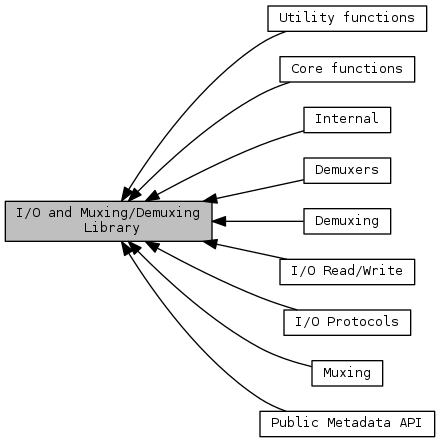|
FFmpeg
|
Libavformat (lavf) is a library for dealing with various media container formats. More...

|
Modules | |
| Demuxing | |
| Demuxers read a media file and split it into chunks of data (packets). | |
| Muxing | |
| I/O Read/Write | |
| Demuxers | |
| I/O Protocols | |
| Internal | |
| Public Metadata API | |
| The metadata API allows libavformat to export metadata tags to a client application when demuxing. | |
| Core functions | |
| Functions for querying libavformat capabilities, allocating core structures, etc. | |
| Utility functions | |
| Miscellaneous utility functions related to both muxing and demuxing (or neither). | |
Files | |
| file | avformat.h |
| Main libavformat public API header. | |
| file | libavformat/version.h |
| Libavformat version macros. | |
Detailed Description
Libavformat (lavf) is a library for dealing with various media container formats.
Its main two purposes are demuxing - i.e. splitting a media file into component streams, and the reverse process of muxing - writing supplied data in a specified container format. It also has an I/O module which supports a number of protocols for accessing the data (e.g. file, tcp, http and others). Before using lavf, you need to call av_register_all() to register all compiled muxers, demuxers and protocols. Unless you are absolutely sure you won't use libavformat's network capabilities, you should also call avformat_network_init().
A supported input format is described by an AVInputFormat struct, conversely an output format is described by AVOutputFormat. You can iterate over all registered input/output formats using the av_iformat_next() / av_oformat_next() functions. The protocols layer is not part of the public API, so you can only get the names of supported protocols with the avio_enum_protocols() function.
Main lavf structure used for both muxing and demuxing is AVFormatContext, which exports all information about the file being read or written. As with most Libavformat structures, its size is not part of public ABI, so it cannot be allocated on stack or directly with av_malloc(). To create an AVFormatContext, use avformat_alloc_context() (some functions, like avformat_open_input() might do that for you).
Most importantly an AVFormatContext contains:
- the input or output format. It is either autodetected or set by user for input; always set by user for output.
- an array of AVStreams, which describe all elementary streams stored in the file. AVStreams are typically referred to using their index in this array.
- an I/O context. It is either opened by lavf or set by user for input, always set by user for output (unless you are dealing with an AVFMT_NOFILE format).
Passing options to (de)muxers
Lavf allows to configure muxers and demuxers using the AVOptions mechanism. Generic (format-independent) libavformat options are provided by AVFormatContext, they can be examined from a user program by calling av_opt_next() / av_opt_find() on an allocated AVFormatContext (or its AVClass from avformat_get_class()). Private (format-specific) options are provided by AVFormatContext.priv_data if and only if AVInputFormat.priv_class / AVOutputFormat.priv_class of the corresponding format struct is non-NULL. Further options may be provided by the I/O context, if its AVClass is non-NULL, and the protocols layer. See the discussion on nesting in AVOptions documentation to learn how to access those.
Generated on Sun Sep 14 2025 06:58:37 for FFmpeg by
 1.8.11
1.8.11